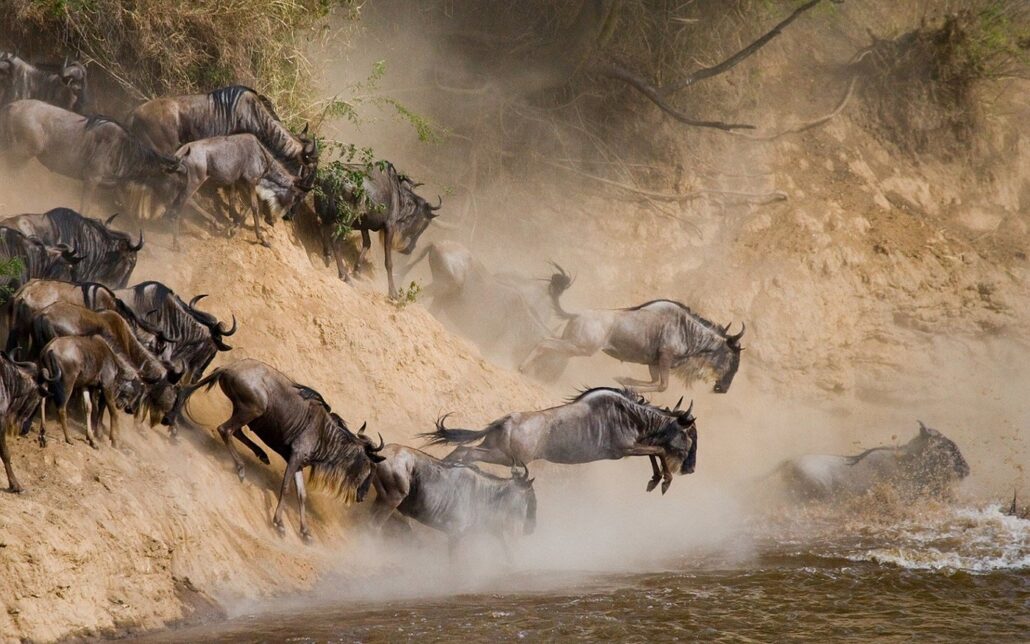Best Time to Visit Masai Mara(Month By Month)
When is the best time of the year to visit Masai Mara National Reserve?The best time to visit Masai Mara National Reserve or the best time to go on a safari in Masai Mara is the long dry season from June to October, yet Masai Mara is open all year round so you can visit whenever!. This is when the animals are concentrated around waterholes & there is low grass level, allowing for better viewing of animals.
July, August, September and October dry months, is usually the best time of the year for a Masai Mara safari for the best game viewing, Migration (Wildebeest) and walking safari conditions. The Reserve also over crowds at this time because the Vegetation is low and Scarce at this time of year, making it easier for animals to be spotted and tracked, while the permanent Mara River offers a rewarding safari experience in the Masai Mara
The world’s famous “Great Wildebeest Migration” season is usually the primary reason for the best time to visit Maasai Mara National Reserve. The epic floods the Savannah with over 2 million Wildebeests, Zebras, antelopes among others from Serengeti over to Maasai Mara, through Magnificent Mara & Talek River Crossing.

While Maasai Mara is an all year round ultimate wildlife viewing destination, Most Visitors plan their safari trips around this season. The altering rainfall patterns changes each year, that sometimes the rains may come early, causing the wildebeests to arrive and leave sooner, and vice verser.
However, the dry months of January, February and March is also regarded as a great time to Visit Maasai Mara National Reserve because of the mild & dry weather, and most safari populations are absent
The long cool-dry season from July through October is most the most perfect safari season to visit Masai Mara National Reserve but also most expensive. The absence of rain means that the vegetation cover is thin, so animals are easily sighted. Additionally, insect levels, including mosquitoes, are lower during the dry season.
Visiting Maasai Mara National Park in January, February & March
While January receives some light rain showers, It is usually the best bird watching season by bird enthusiasts, because the migratory birds from Europe as well as North Africa arrive in the park and can be spotted frequently in the area. Nonetheless, part of January, February up to Mid-March is the best calving(birthing) season, when there is plentiful new life in the region, which makes it the best time of the Year to avoid large crowds when visiting Maasai Mara National Reserve.
The three months are also termed as the Lion Season, because travellers are able to spot individual Lions, prides of Lions, dashing through the Maasai Mara National Reserveplains.
Towards the end of March, Maasai Mara National Reserve begins receiving rains and thunderstorms, most especially in the afternoon hours.
Visiting Maasai Mara National Reserve in April & May (Green Season)
April & May are the wettest months of the year, with increased level of long rain downpour which causes some lodges to close, as they refurbish & renovate as well as offering their staff an off season break.
The heavy rains covers the dusty plains with green cover, which later hosts several Young Impalas, antelopes, zebras among other habivores
Visiting Maasai Mara national Reserve in June, July & August
June, July, August, September & October experience pleasant, warm & dry temperatures, with mostly clear blue skies, providing an ideal moment for game safaris
The Month of June, usually marks the beginning of the cooler season, and the end of the long rains, while the dense vegetation cover is still virgin, making it hard for the animals to be spotted.
The glorious Month of July is when the Wildebeest herds start to arrive in Maasai Mara National Reserve, from Serengeti National Park. The weather conditions feels warm with cold early mornings and late evenings.
July, August & September, though busy, are great months of wildlife viewing. These driest months of the year draw wide concentration of animals closer to the water sources including the Big Five(5) in Maasai Mara Game Reserve. This season showcase frequent Great migration (renowned Mara River crossing), although they are unpredictable. That said, the migration may stay silent for some weeks, and cross over 4 times during the weeks.
Visiting Maasai Mara National Reserve in October & November
October is one of the Hottest months to visit Maasai Mara, and a few wildebeest herds can still be spotted in & around Mara, while in November showcase the final stages of migration where numerous wildebeest herds move south of Serengeti Calving grounds, although they may be interrupted by rains anf afternoon thunderstorms in October & November.
Visiting Maasai Mara in December
Early December, is usually less busy, but gets busy during the festive season period to the end of February.
What is the difference between Dry Season & Wet Season in Maasai Mara National Reserve.?
Dry Season – June, July, August, September, October
Pros
Less rain, less vegetation, for an ideal wildlife viewing
High Population of wildlife concentrated nearby waterholes and rivers.
Pleasant weather, with little or no rain.
Less/No mosquitoes hence less chances of malaria.
The best time of year to experience the Great Migration.
Cons
Busiest season with highest congestion travelers in the reserve for the great Migration,
Travel is more costly this time of year, than prices in the low season are much more favorable.
Cold evenings and very chilly early morning game drives.
Rainy season – November through May